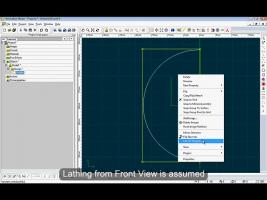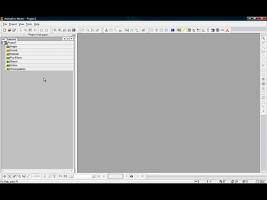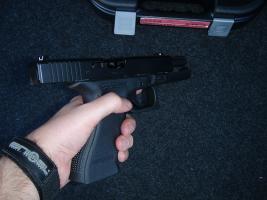-
Posts
21,633 -
Joined
-
Last visited
-
Days Won
114
Content Type
Profiles
Forums
Events
Everything posted by Rodney
-
Here's my contribution. I don't have the plugin so this is Midi driven. A simple bone rotation steadily increasing... rising.mp4
-

FXFactory (Free and $ Plugins) for FCP, Premiere, AE etc.
Rodney replied to Rodney's topic in Open Forum
Ouch. Sorry about that. I might have steered clear if I had known that. Still, they might be of use to the Mac users 'round here. -
Ah well... those things happen. For what it's worth you can use the Comma key too. Just use one of the manipulators to ensure the pivot is in the right location for lathing. Since we are here... For the curious here is an example of Lathing anywhere you want from the Front View. A:M Assumes Lathing is from the Front View unless told otherwise via one of the manipulators. I tend to use the Rotate Manipulator but you can use any of them.
-
Here is a quick down and dirty walkthrough of Lathing a Sphere from the Front View: Note that most people lathe with the spline on the Right side of the axis but I learned to do it on the left and it's hard to change old habits...
-
Make sure you are in front view. It's not required but if you are in another view you'll have to tell A:M what your orientation is via one of the manipulators (Rotate, Move, etc). Most people just use the Front view. Also, you'll want to move the spline 1 cursor key over to the side to prevent pinching at the top and bottom. I'll see if I can put together a quick demo for you... stand by... I thought I had a tutorial handy but don't see it at the moment. Here is a writeup on advanced lathing methodologies: http://www.hash.com/forums/index.php?showtopic=9103 A gif tutorial of lathing a sphere from Front View is rendering right now...
-
If you have one of the programs that support FXFactory you likely know about this already but... FXFactory is a plugin interface for a large number of free and purchasable effects for Final Cut Pro, Adobe Premiere, Adobe After Effects etc. Some of the effects are demos while others are entirely free. For those interested, check it out here: http://www.noiseindustries.com/fxfactory/ These are supposedly free: http://www.noiseindustries.com/fxfactory/free/
-
Thanks. I'll wait for it. I'm a bit surprised (but pleased) it didn't get reserved for v18.
-
At the risk of... whatever.... I'll add the following suggestion. While I know this is for a still I think you'll want to make the slide a separate piece of the weapon in order to: 1. Make it look more realistic. (Having it as a separate piece would also make it easier to bevel) 2. Make it functional in the primary place the weapon would be seen to function (the other would be be the trigger and the hammer) I recall my drawings of weapons before I became a firearms instructor looked like solid chunks of metal that had no internal working parts. While I don't tend to make my weaponry completely functional and real I do try to hint at something underneath the exterior that would be able to send a bullet down range. Having the slide appear to be a separate part, even if it isn't can achieve that sense of realism. Looking good thus far! Edit: It occurs to me that you may be heading in the direction of a separate slide already because of the 'dangling splines' that David (itsjustme) Simmons was talking about... Here's an image of a glock with the slide locked back to the rear:
-
Thanks ya'll, you make birthdays worth having.
-
How does one get access to this new plugin. Is it pending release of v17e? I'm curious to compare it with the Midi plugin (which BTW is quite an excellent tool). I've been using the freeware program Aria Maestosa to create the midi instructions/music to drive the animation in A:M. There are quite a few places we can right click and use a Midi file to drive animation that I'm curious if Wav files are treated simularly. No rush... just curious if I missed an announcement or link to the plugin. Added: For those that want to create Midi files to drive animation check out Aria Maestosa: http://ariamaestosa.sourceforge.net/ If desired you can use other utilities to convert the Midi files to WAV. The program will run on Mac OS X, Windows and Linux/Unix.
-
Knowzing Robert'z exzacting standardz mez knowz itz gotz tooz beez perfectz.
-
RE: This image would work pretty well as an intermediately difficult example of SSS excepting there are three areas that seem to be lacking: - The evidence of bones underneath skin (this can be seen primarily in the jaw and forearm areas) - The hand (while perhaps in the right position) doesn't look correctly positioned - The spine/back appears to be deformed Adding bones would probably push this well into the 'too complicated' arena. All for what it is worth here...
-
Thanks guys! This last year was quite the experience. Here's hoping 2013 passes with a bit less drama, pain and unnecessary expense. Thus far... so good!
-
I don't think you'll see much motion blur in the sneak but you should in the final movement out of frame. In relooking at your sequence I'd say you'll need a keyframe of the character all the way off screen to get the blur to fully effect that final movement (the leap off screen). There isn't enough to blur at present in the current frames IMO. You should see some from the one position to the last frame but that won't look like he's leaping off screen. Note: It's not clear to me what he is doing in that action between the sneak and the jumping off frame. I don't know your intention but I'd think a look toward the spotlight would work as a nice anticipation before leaping off screen.
-
Two things I can think of that I forgot to mention: Ease (Slow In and Slow Out) and Rerendering frames that you've already rendered without any motion blur. In the first case adjusting the Ease of any motion can substantially change the motion blur of any movement. Try a three keyframe sequence with different Ease (Slow In, Slow Out and Linear) and you'll see the the difference that can make. When rendering frames this give you the ability to retime (and blur) sequences that you've already rendered. I've noted that we can get some really nice motion blur from images and I suspect it's because A:M is limited in what it can change. It can only blur what is there already.
-
I'm not aware of any specific tutorial regardng motion blur outside of Marcos's MUFOOF method to blur objects on the subframe level. The primary considerations in motion blur are Keyframes and Multipass which equate to Timing and Spacing with respect to what will be burred due to motion. In general, the more passes you render with Multipass the smoother the resulting blur will be. The real trick I have found is make sure you leave enough inactive objects/frames with little or no movement as needed to complement the frames that will be blurred. Otherwise everything will appear blurred. I would say that its generally a good idea to have a few anticipatory frames moving in the opposite direction as well so that the viewer will be able to more easily 'read' the blurred motion. Control is really what we are after in Motion Blur so it helps to keep an eye on what is changing (and what we don't want to have blurred). If you know that there are some frames that you don't want to have any blur occuring you might want to render those separately without any blur. These nonblurred frames can give a nice contrast to the sudden/blurred movement. To augment the motion blur consider squash and stretch also.
-
I know the Tinkering Gnome has examples of rain hitting the ground. I'm guessing you need more close up effects than that? Ben de Leeuw has a nice example of a fairly large splashing effect (w/ project file): HERE I believe that is the Surface Flocking version... the spriticle version is: HERE
-
RE: Lloyd's reference video It might just be me but... I find that jump to look really cool in reverse. Pretty impressive jump too (especially without the use of your arms).
-
One of Matt Campbell's recent renderings combines SSS with... just about everything else: I believe Matt donated that project to the A:M Community.
-
Yet another 'fake SSS' work in progress: One is real... one is fake... This one by Anders Averö.
-
Another 'fake SSS', this time by J Griffin: Ref: Link
-
Similar to Nancy's chart, Matt Bradbury posted his analysis of SSS. Here is one of the results: Here's the whole topic (with useful information): LINK
-
Nancy posted a chart of some SSS settings:
-
This one kind of goes against the primary purpose of demoing SSS but it does illustrate that there is more than one way to achieve an effect in A:M. Remember this result after Elm (from Soulcage Dept) posted about 'faking SSS' in a render? (You rendered it) Here's the link to that discussion.
-
Plastic look? This one is by Tai Shan. Paul Daley render Anuld:












